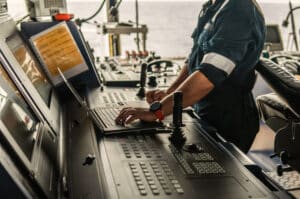Naval vessels operate in some of the most challenging environments, often traveling vast distances in hostile waters while remaining isolated from traditional infrastructure. Ensuring secure, reliable, and continuous communication for these vessels, particularly during long-range missions, is critical to maintaining operational effectiveness, mission success, and the safety of personnel onboard. The need for seamless connectivity has become even more pressing as the U.S. military plans increasingly complex operations involving multiple commands and international partners.
One such mission planned for 2025 highlights the challenge. According to Daniel Holtzman, the Chief Information Officer for the Pentagon’s Chief Digital & AI Officer, the U.S. will lead a carrier strike group across three different U.S. Combatant Commands (COCOMs) and through the waters of four international partners. Holtzman, who oversees the Global Information Dominance Experiments (GIDE), stated that these upcoming experiments are laying the groundwork for this mission. The goal is to test the U.S. Navy’s ability to keep an aircraft carrier and its escorts continuously connected in the high seas while crossing multiple jurisdictions.
This operation underscores the increasing complexity of modern naval operations and the critical role of uninterrupted connectivity.
The Connectivity Challenge

Connectivity is difficult for vessels far beyond the reach of conventional communication infrastructure, forcing them to rely on satellite communications (SATCOM) and other specialized systems.
Long-range missions like the one planned for GIDE 2025 require naval vessels to maintain continuous communications even as they pass through different regions and engage with various military partners. These missions often take vessels far beyond the reach of conventional communication infrastructure, forcing them to rely on satellite communications (SATCOM) and other specialized systems.
Traditional SATCOM systems offer a partial solution but face limitations such as bandwidth restrictions, latency, and vulnerability to interference. As naval operations evolve, the demand for higher data throughput and real-time communications only increases. Operations like the upcoming GIDE test require integrated networks that support real-time intelligence, surveillance, and reconnaissance (ISR), mission planning and secure communication channels that can remain reliable across vast distances.
Bridging the Connectivity Gap
To bridge the gap between the limitations of traditional communication systems and the growing demands of modern naval operations, the Navy will need advanced communication systems. These solutions combine SATCOM with tactical edge networks, ensuring real-time data sharing between naval forces, other military branches, and allied nations. This capability will be particularly vital as the U.S. Navy prepares to execute multi-jurisdictional operations like the GIDE experiment in 2025, where a carrier strike group will traverse international waters under multiple COCOMs.
Protecting the Digital Battlefield

On long-range vessels, a well-timed cyberattack could quickly disrupt communications and compromise sensitive data.
Maintaining connectivity is only part of the solution. As naval vessels rely more heavily on integrated communication networks, cybersecurity becomes a critical concern. The possibility of cyberattacks on disconnected or vulnerable systems poses significant risks to mission success. A well-timed cyberattack could disrupt communications, compromise sensitive data, or even endanger the lives of naval personnel.
Supporting Naval Innovation and Mission Success
As modern naval missions grow in complexity, the importance of interoperable systems is paramount. Long-range operations often involve collaboration between multiple military branches and international partners, requiring seamless communication systems that can interface across different jurisdictions and platforms. Interoperable networks enable more efficient data sharing, real-time intelligence exchange, and coordinated responses across various commands.
Naval vessels, particularly during missions that traverse multiple regions, benefit from systems that can adapt to changing operational environments. This adaptability ensures that critical data and communications flow uninterrupted, allowing for better coordination and more effective mission execution. As a result, interoperability isn’t just a technical requirement but a strategic imperative for naval success in increasingly complex global missions.
By embracing interoperable systems, the U.S. Navy can remain agile and responsive in an unpredictable operational landscape where coalition forces and multinational partners must work together efficiently. These systems will be integral to supporting mission success in long-range operations such as the GIDE 2025 experiment, where multiple regions, commands, and nations will need to synchronize their efforts to achieve mission objectives.
Stay Informed on the Latest in Military Technology
For more insights on emerging trends, challenges, and solutions in defense technology and military operations, subscribe to SealingTech’s newsletter, The Lightning Report. Stay updated with expert analysis, industry news, and innovative strategies that drive mission success across complex operational environments. Connect with us to remain at the forefront of military technology advancements.
Related Articles
Delivering More Agility, More Portability through Powerful Compact Solutions
For the first time, SealingTech exhibited at the AUSA Global Force Symposium & Exposition in Huntsville, Alabama. With a large number of Huntsville natives in attendance, it provided a good…
Leveraging Supercomputers on Demand for Advanced Defense Capabilities
The defense landscape is evolving rapidly, and developers are just getting started applying computational power to long-standing challenges, from real-time threat detection to advanced simulations. While traditional computing solutions will…
Navigating the Surge in Chinese High-Tech Exports
The global technological landscape is undergoing a significant transformation, with China’s high-tech export surge at the forefront of this shift. While this surge highlights the nation’s growing influence in advanced…
Could your news use a jolt?
Find out what’s happening across the cyber landscape every month with The Lightning Report.
Be privy to the latest trends and evolutions, along with strategies to safeguard your government agency or enterprise from cyber threats. Subscribe now.